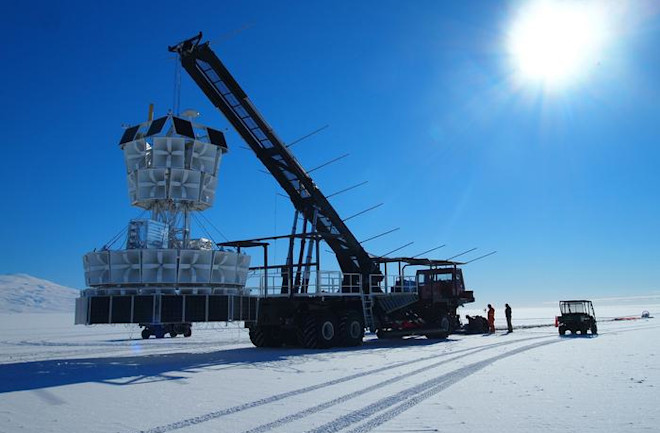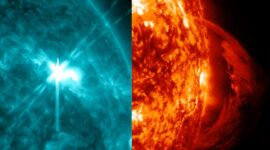June 17, 2025, ANITA‑detected pulses which were captured around 40 km altitude; coming from beneath the horizon, they might hint at entirely new particles or interactions. The radio waves don’t align with neutrinos; potential theories range from dark matter interactions to radio‑propagation effects in polar ice. Such events occurred first in 2006 and again in 2014, pointing to a stimulus beyond neutrinos.
Detailed analysis of the news
The story begins with the Antarctic Impulsive Transient Antenna (ANITA)—a high-altitude balloon experiment funded by NASA and launched by scientists from the University of Hawai‘i, Penn State, and other institutions. The primary goal of ANITA was to detect ultra-high-energy cosmic neutrinos interacting with the Antarctic ice, producing faint radio signals through a process called the Askaryan effect. Between 2006 and 2016, four major flights (ANITA-I to ANITA-IV) were conducted at altitudes of 35–40 km above the Antarctic continent.
During its first flight in 2006, ANITA detected something unusual—radio wave signals that appeared to come from deep below the surface, at angles far steeper than what standard physics would allow. These upward-pointing pulses seemed to have traveled through thousands of kilometers of solid Earth, an impossible feat for known particles like neutrinos. Despite rigorous data checks, these anomalies persisted. Similar signals reappeared in 2014, during the ANITA-III flight, further deepening the mystery. These events were consistent with tau-lepton air showers, possibly caused by neutrinos, but the angle and strength contradicted predictions of the Standard Model of particle physics.
Scientific Investigations and Cross-Verification
Given the bizarre nature of the findings, several scientists and institutions investigated the data. Key researchers involved include Stephanie Wissel (Penn State), Peter Gorham (University of Hawai‘i), and collaborators from institutions like the Pierre Auger Observatory in Argentina. A 2025 study led by scientists including M. Zavrtanik, R. Prechelt, A. Romero-Wolf, and A. Zeolla sought to verify whether the upward-pointing radio events seen by ANITA had any counterpart in other large-scale observatories. The Pierre Auger Observatory, which has been monitoring cosmic rays for 15 years, found no similar upward-pointing events, ruling out known neutrinos as the source.
These findings were published in mid-June 2025 in Physical Review Letters and widely covered by science media outlets such as Space.com, ScienceAlert, and ScienceDaily. The new results suggested that ANITA’s observations could not be explained by conventional tau-neutrino interactions. With the Standard Model effectively ruling out such possibilities, scientists were left speculating whether unknown physics or instrumental errors were to blame.
Possible Theories and Scientific Implications
The implications of these anomalies are profound. One explanation could be the presence of exotic new particles—possibly linked to dark matter or other beyond-the-Standard-Model phenomena. Another theory suggests that these might be undiscovered propagation effects in Antarctic ice or the atmosphere, which could distort or reflect signals in unusual ways. However, no such mechanisms are currently known or confirmed. A less exciting but still plausible explanation is instrumental error or environmental interference, although this seems unlikely given ANITA’s careful design and multiple detections across different flights.
Whatever the cause, these upward-pointing radio pulses challenge existing assumptions about how high-energy particles interact with Earth’s atmosphere and surface. If proven to arise from new physics, they could represent the first observational evidence of particles or interactions beyond the current framework of physics. This makes the ANITA anomalies one of the most intriguing unsolved mysteries in astroparticle science over the past two decades.
Future directions
Although ANITA’s final flight was in 2016, the legacy of its discoveries lives on. The upcoming project PUEO (Payload for Ultrahigh Energy Observations) is being developed as a next-generation balloon experiment, designed to have significantly improved sensitivity and better resolution. Scientists hope PUEO will help detect more such anomalous signals and provide the data needed to definitively determine their source. Scheduled for launch in the coming years, PUEO may finally solve the enigma first uncovered by ANITA.
The mystery of the Antarctic radio pulses is far from resolved. Whether it’s a case of new physics, a rare natural phenomenon, or something yet entirely unimagined, the upward-pointing events continue to fuel intense debate. For now, they stand as a provocative clue—one that hints at the limits of our understanding and the possibility of groundbreaking discoveries just over the scientific horizon.




